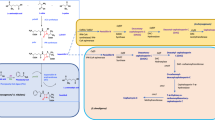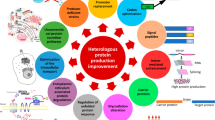Summary
The neo genes of Tn5 and Tn903 (Tn601) coding for amigoglycoside phosphotransferase type II and type I, respectively, were joined to the yeast adc 1 promoter and trp1 terminator and introduced into yeast (Saccharomyces cerevisiae) cells. Transformants were obtained by direct selection for G418 resistance. Plasmids containing the Tn5 neo gene induced antibiotic resistance only at low frequency, whereas colonies transformed with the Tn903 neo gene could be selected at high frequency (300–400 transformants/μg plasmid DNA). The resistance threshold of transformed strains was increased to 30 mg G418/ml by both genes and high level expression of the bacterial genes in yeast could be shown using an in vitro phosphotransferase assay. The results indicate that this system can be used for high frequency transformation of wild-type strains and might in addition be used for the identification and isolation of promoter-active sequences.
Similar content being viewed by others
Abbreviations
- adc 1 :
-
alcoholdehydrogenase I gene
- APH:
-
aminoglycoside-3′-phosphotransferase
- leu2 :
-
β-isopropylmalate dehydrogenase gene
- neo :
-
aminoglycoside-3′-phosphotransferase gene
- trp1 :
-
N-(5′-phosphoribosyl)-anthranilate isomerase gene
References
Beck E, Ludwig G, Auerswald EA, Reiss B, Schaller H (1982) Nucleotide sequence and exact localization of the neomycin phosphotransferase gene from transposon Tn5. Gene 19:327–336
Bennetzen JL, Hall BD (1982) The primary structure of the Saccharomyces cerevisiae gene for alcohol dehydrogenase I. J Biol Chem 257:3018–3025
Colbère-Garapin F, Horodniceanu F, Kourilsky P, Garapin A (1981) A new dominant hybrid selective marker for higher eukaryotic cells. J Mol Biol 150:1–14
Davies J, Smith D (1978) Plasmid-determined resistance to antimicrobial agents. Annu Rev Microbiol 32:469–518
Foster TJ (1983) Plasmid-determined resistance to antimicrobial drugs and toxic metal ions in bacteria. Microbiol Rev 47:361–409
Fraley RT, Rogers SG, Horsch RB, Sanders PA, Flick JS, Adams SP, Bittner ML, Brand LA, Fink CL, Fry JS, Galluppi GR, Goldberg SB, Hoffmann NL, Woo SC (1983) Expression of bacterial genes in plants. Proc Natl Acad Sci USA 80:4803–4807
Gatignol A, Baron M, Tiraby G (1987) Phleomycin resistance encoded by the ble gene from transposon Tn5 as a dominant selectable marker in Saccharomyces cerevisiae. Mol Gen Genet 207:342–348
Gritz L, Davies J (1983) Plasmid-encoded hygromycin B resistance: the sequence of hygromycin B phosphotransferase gene and its expresion in E. coli and S. cerevisiae. Gene 25:179–188
Haas MJ, Dowding JE (1978) Aminoglycoside-modifying enzymes. Methods Enzymol 43:611–628
Hadfield C, Cashmore AM, Meacock PA (1987) Sequence and expression characteristics of a shuttle chloramphenicol-resistance marker for Saccharomyces cerevisiae and Escherichia coli. Gene 52:59–70
Hasnain SE, Manavathu EK, Leung W (1985) DNA-mediated transformation of Chlamydomonas reinhardii cells: use of aminoglycoside 3′-phoshorylase as a selectable marker. Mol Cell Biol 5:3647–3650
Hollenberg CP (1979) The expression of bacterial antibiotic resistance genes in the yeast Saccharomyces cerevisiae. In: Timmis KN, Pühler A (eds) Plasmids of medical, environmental and commerical importance. Elsevier/North Holland, Amsterdam, pp 481–492
Ito H, Fukuda Y, Murata K, Kimura A (1983) Transformation of intact yeast cells treated with alkali cations. J Bacteriol 153:163–168
Jimenez A, Davies J (1980) Expression of a transposable antibiotic resistance element in Saccharomyces. Nature 287:869–871
Kaster KR, Burgett SG, Ingolia TD (1984) Hygromycin B resistance as dominant selectable marker in yeast. Curr Genet 8:353–358
Knecht DA, Cohen SM, Loomis WF, Lodish HF (1986) Developmental regulation of Dictyostelium discoideum actin gene fusions carried on low-copy and high-copy transformation vectors. Mol Cell Biol 6:3973–3983
Maniatis T, Fritsch EF, Sambrook J (1982) Molecular cloning. A laboratory manual. Cold Spring Harbor Laboratory, New York
Matsuhashi Y, Yagisawa M, Kondo S, Takeuchi T, Umezawa H (1975) Aminoglycoside 3′-phosphotransferase I and II in Pseudomonas aeruginosa. J Antibiot 28:442–447
Nellen W, Silan C, Firtel RA (1984) DNA-mediated transformation in Dictyostelium discoideum: regulated expression of an actin gene fusion. Mol Cell Biol 4:2890–2898
Nutter R, Everett N, Pierce D, Panganiban L, Okubara P, Lachmansingh R, Mascarenhas D, Welch H, Mettler I, Pomeroy L, Howard J (1987) Factors affecting the level of kanamycin resistance in transformed sunflower cells. Plant Physiol 84:1185–1192
Oka A, Sugisaki H, Takanami M (1981) Nucleotide sequence of the kanamycin resistance transposon Tn903. J Mol Biol 147:217–226
Ozanne B, Benveniste R, Tipper D, Davies J (1969) Aminoglycoside antibiotics: interaction by phosphorylation in Escherichia coli carrying R factors. J Bacteriol 100:1144–1146
Plant SG, Yang N (1987) Dot assay for neomycin phosphotransferase activity in crude cell extracts. Anal Biochem 162:529–535
Reipen G, Erhart E, Breunig KD, Hollenberg CP (1982) Nonselective transformation of Saccharomyces cerevisiae. Curr Genet 6:189–193
Revuelta JL, Jayaram M (1986) Transformation of Phycomyces blakesleeanus to G418 resistance by an autonomously replicating plasmid. Proc Natl Acad Sci USA 83:7344–7347
Sakai K, Yamamoto M (1986) Transformation of the yeast, Saccharomyces carlsbergensis, using an antibiotic resistance marker. Agric Biol Chem 50:1177–1182
Thiry-Blaise LM, Loopes R (1988) Promoters active in mammalian cells (pSV40) and in plants (pNOS) permit expression in yeast of the Tn5 APH(3′)II gene. FEMS Microbiol Lett 50:121–125
Trieu-Cuot P, Courvalin P (1986) Evolution and transfer of aminoglycoside resistance genes under natural conditions. J Antimicrob Chemotherapy 18 Suppl C:93–102
Tschumper G, Carbon J (1980) Sequence of a yeast DNA fragment containing a chromosomal replicator and the TRP1 gene. Gene 10:157–166
Wang H, Daves R, Yocum R (1988) Genetic engineering of industrial yeasts. Yeast 4:S 25
Webster TD, Dickson RC (1983) Direct selection of Saccharomyces cerevisiae resistant to the antibiotic G418 following transformation with a DNA vector carrying the kanamycin-resistance gene of Tn903. Gene 26:243–252
Author information
Authors and Affiliations
Additional information
Dedicated to Prof. Dr. Dr. h. c. Karl Esser on the occasion of his 65th birthday
Rights and permissions
About this article
Cite this article
Lang-Hinrichs, C., Berndorff, D., Seefeldt, C. et al. G418 resistance in the yeast Saccharomyces cerevisiae: comparison of the neomycin resistance genes from Tn5 and Tn903. Appl Microbiol Biotechnol 30, 388–394 (1989). https://doi.org/10.1007/BF00296629
Received:
Accepted:
Issue Date:
DOI: https://doi.org/10.1007/BF00296629




